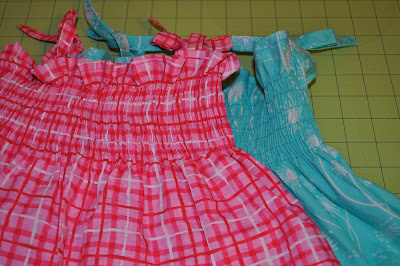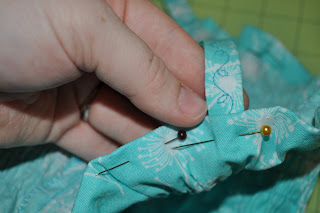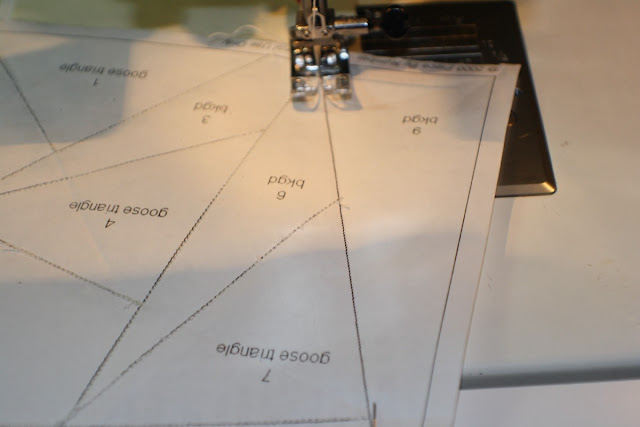Hey guys! Guess I should finally get around to relieving Julie of all the posting privileges, huh?
I've been hemming and hawing over what sort of tutorial to do for my first post, and kept crashing into the issue that almost every single project I have has already been done... and done right here in the blogging world! My favorite quote is as follows: "The key to creativity is concealing your sources" - but I think I'll break that here. The creative world is about sharing, learning, and inspiring. So my first tutorial here at Distant Pickles is one you may have seen before, but it's one of my favorite easy projects to do, and a super cute gift to give!
This is a dress I refer to as the "Naptime Dress". It is referred to as such because it is able to be done, from start to finish, in about an hour - perfect for even short nappers!
It is a simple smocked sundress. Martha Stewart did a spot on it in May of 2009 - video can be found
here. The problem I've found with the video, though, is that there are no closeups of what she is doing! So, today, I'm going to go ahead and give a close up, step-by-step image tutorial for any steps that you might not quite get by watching Martha's video.
The Naptime Dress tutorial will fit a toddler in size 18-24 months. After the 24 month/2T size, it becomes a little short to use alone, but because of the elastic smocking, it can still be worn as a shirt for older kiddos!
You're going to start with the supply list:
Your trusty cutting mat, acrylic ruler, rotary cutter, and snips. I heart my snips. Everyone should own a pair or 12.
Pins, pincushion, thread, and a bobbin wound with elastic thread. Elastic thread can be found in the same section as traditional elastic and Velcro at Joann's. The bobbin must be wound by hand - take care not to wind too tightly or too loosely. Any variations will mess up the smocking. Don't stress about it too much - just grab a few spare bobbins and wind by hand while you watch a movie. If you pay much attention to it, you're more likely to mess up and pull some spots too tight and some too loose!
Note on the pincushion - this baby is magnetic. I strongly suggest them. You can just sorta flick the pin over in the general direction of the pincushion as you're sewing, and it hits the pincushion every time! Raise your hand if you've ever had to stop sewing in order to finagle a pin into a traditional cushion. Pain, right?!
Iron. Don't laugh. She's been with me through thick and thin. (I know, I could use an upgrade.)
Your sewing machine. Meet Francine. She is a Singer 7469Q. I might have a slight girl-crush on her.
And last, but most important - your water soluble marking pen.
For the 18-24 month size dress, you'll need a 1/2 yard cut of fabric. Cotton or apparel cottons work fine for this! I like to give 3 dresses in a little bunch - I have a strange notion that things in threes are aesthetically pleasing, so most things I make are in trios! Pick out a coordinating bunch, and the toddling princess in your life will have a summer wardrobe kick-start in a day's time.
Do any prewashing now. If you're a rule-breaking lazy person like me, skip the prewashing and just iron. :)
First step: cutting off the pesky selvages. They're typically ugly, and shrink differently from the rest of the cut. Get rid of them! Fold your piece of fabric in half, matching selvages. My selvage was close to a full inch, so I just chopped off that inch:
Now, unfold that fabric. Bring it back to the ironing board - we're going to create the top hem. Do NOT sew after this step. I know I'm guilty of getting ahead of the instructions that I'm reading, and occasionally sew something and realize I shouldn't have. Resist the temptation!
You need to fold over and press down 1/2 inch from the top of your long side of the fabric. Once this is pressed down, repeat the step and press down another 1/2 inch from where you've just pressed. This creates a neat hem with no raw edges sticking out.
Remember - do not sew this pretty hem line! If you sew it now, the elastic thread is going to have a much harder time doing its job.
Now, with the hem pressed down to where it needs to be, fold your fabric in half, wrong sides together. Lay it flat on your cutting surface, and line up your hem side with a marked line on the board.
Grab your acrylic ruler. Chances are, your cut isn't perfectly even unless your cutting counter clerk is a perfectionist. And if your cutting counter clerk IS a perfectionist, please share her with the rest of us. It gets frustrating when one side of your "1/2 yard cut" is only 15" long. :)
You'll need to square up the bottom of the dress here. Your top hem is lined up with a marked line on your cutting board already - you want to cut off as little material as possible. Figure out where the shortest point on your dress is, and line up the ruler there. Cut off any excess, and make your fabric nice and square again. Most likely, you're now looking at a 17" tall piece of fabric.
Now, you're going to cut off 2". This 2" strip is going to become your straps, so save it for later!
Now, with your fabric still lined up, we need to mark the lines that we'll follow when we sew. I like to do 6 lines of smocking on this size. The bigger the size, the more lines you'll need.
Start 1" to the right of your top hem. In this photo, I started 1.5" to the right. It looks weird in the final product - stay with the 1" line. Mark along the entire length of your folded fabric.
Once this line is marked, move your acrylic ruler 1/2" an inch over and repeat your line:
Repeat this until you have 6 lines marked, each 1/2" apart.
Flip your fabric over and repeat on the other half of the material - make sure to line up your marking lines so they match in the middle!
From here, we'll move to the sewing machine. Your top thread is going to be a coordinating or contrasting color. I tend to like things that pop out a bit, so I used a slightly bolder blue for my lines. You can certainly use something that coordinates and blends in with the fabric a little better. Your elastic thread is in your bobbin.
Do not back stitch at the beginning or end of any of these lines. Using your straight stitch with a medium stitch length, follow straight down each of the lines:
After just two lines, you can see the elastic thread is already starting to gather a little!
Repeat for all six marked lines.
Now, it's time to watch the elastic thread work its magic! Take your material to the ironing board. If you have a spray bottle, go grab it and fill it up with water. If not, just flick some water on with your hands. You want to lay out your fabric straight across your ironing board like so:
If you have a helper, it's certainly handy. If not, pin down one side of your fabric to the actual board itself:
Soak the elastic area of your fabric. The water is going to make the marking lines from your pen disappear, and the steam that is created by the iron hitting the water is going to cause your elastic bobbin thread to shrink up, which completes the smocking look!
Stretch out your fabric with your hands, and start ironing from the right to the left. Let go of the right side of the fabric as you're ironing over it, and it will shrink up and "follow" the iron across the board. Your pins act as your second set of hands to hold the fabric totally stretched out while you complete this step.
Now, you have a smocked piece of fabric!
From here, you're going to fold your dress in half, right sides together. Starting about an inch from the side, you're going to make your side seam.
Sew down the length, and then trim off the excess to about .5". If you have a serger, use it here to create a nice finished edge. If you do not have a serger, a simple zig zag stitch will suffice. Make sure your zig zag stitch goes over the edge of the fabric, so it encases it and stops fraying.
While you've got your machine set to the zig zag stitch, go ahead and do the same edging on the bottom of the dress to stop fraying there, as well.
Now, put the dress aside for a few minutes and grab that pretty 2" strip we cut off earlier! It's time to make the straps!
Start by finger pressing a 1/4" fold from one side of the strip like so:
Do this for the entire length of the strip, and then repeat to fold the other side down. What you'll end up with is this:
Press flat with your iron, and then fold the bottom side up to meet the top side, and press:
I find it easier to do this to the entire strip at once, but you can certainly cut your strip into four even sections prior to starting the above folding and pressing process. If you did fold and press the entire strip at once, you'll now need to cut the strip into four even sections. I typically fold the strip over onto itself and cut at the halfway mark - then cut each of the two strips made by that cut into two even sections. No matter how you cut, you'll now be looking at this:
Now we're going to take these strips and make one end of each nice and pretty. The other end of your strap is going to be tucked into the dress seams, so it is not necessary to fold it under at this time. To create a nice end, you're going to unfold the strip so it is 2" wide again. Don't press - you'll just make more work for yourself. :)
With your strap unfolded, take that one end and finger press it in a scant 1/4". Press down lightly to keep it in place:
Then fold your strap back up the way it was before, now with the end tucked in, and you'll have your straps almost complete!
From here, you need to stitch the straps so they stay together. I like to use my machine's decorative stitches on the straps on occasion. The decorative stitches don't get used that often, and I think they make a cute little accent on small straps. If you're using a coordinating color, they're incredibly subtle accents. I chose a leaf and vine stitch for my straps. You can also just do a simple straight stitch up the edge - really, all you're aiming to do is keep your strap from unfolding. :)
Once you've stitched up each of the four straps, bring them back to the ironing board, and fold up the unfinished end 1/2" and press as shown:
This 1/2" press is going to tuck up into that top hem we never sewed. Remember that? Grab the dress - it's time to attach the straps!
First, mark with pins where your straps will be. I don't typically measure this - I generally do it by sight. You want them even with each other, and an even distance from the center back seam, so I start with the back straps, to make sure things are even! Laying your dress face down on your table, place a pin a few inches to the left of your center back seam. Fold the dress in half at the seam, and place your other pin opposite where your left pin appears. These two pins mark your center back spot. Now, you'll need to tuck your straps up into the hem fold, and pin into place for sewing.
First, tuck it under the hem:
Then, fold it up flush with the hem, so your strap sticks out the top:
And pin into place!
Note: if you've used a decorative stitch on your straps, make sure the top of the stitching is facing out. The backside of my leaf and vine stitching is not quite so pretty as the stitching on top, and it'd be a shame to have ugly straps!
Now, we're going to do a straight stitch around the top, to keep everything in place and finalize the hem. A 1/4" seam is perfect here. You've folded down 1/2" inch, but if there are any imperfections in the folding, stitching at 1/4" will still be sure that you won't miss any of the hem. Also, keeping the stitch close to the top of the dress makes your straps stay even with the dress. If you sew at 1/2", your straps aren't going to be flush with the top, and you'll have a situation where the dress top is flopping down a little bit.
Complete this stitching without stretching out your smocking. Just let the machine do most of the feeding of the fabric for you. Keep the fabric smooth, but don't pull on it, or it'll stretch out the smocking and leave a funky, undesirable look at the top!

Now, press up your bottom hem 1/4" and run a quick straight stitch along the bottom to hem, and you have a completed Naptime Dress!
If anyone completes a naptime dress, please share pictures! I don't have a model of the correct gender to show off the finished product. :)





































































































